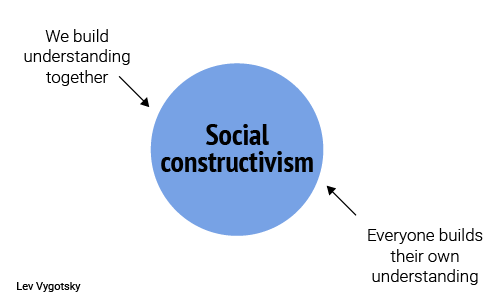
Social Constructivism in Early Childhood Education
The membership committee and I welcomed 63 families to our school through our tours, classroom observations and individual information sessions. A central question in each meeting was, “what does a constructivist educational philosophy really mean?” Just in case you have been waiting for a talking-points cheat sheet so you too can explain this at cocktail parties, here is a what a constructivist educational philosophy is, in a nutshell:
We value the image of the child. All children have preparedness, potential, curiosity; they have interest in relationship, in constructing their own learning, and in negotiating with everything the environment brings to them. Children should be considered as active citizens with rights, as contributing members, with their families, of their local community. Children with special rights (rather than using the term special needs) have precedence in becoming part of an infant/toddler center or a preschool.
We understand children's relationships and interactions within a system. Education has to focus on each child, not considered in isolation, but seen in relation with the family, with other children, with the teachers, with the environment of the school, with the community, and with the wider society. Each school is viewed as a system in which all these relationships, which are all interconnected and reciprocal, are activated and supported.
We value and partner with parents. Parents are an essential component of the program; a competent and active part of their children's learning experience. They are not considered consumers but co-responsible partners.
Their right to participation is expected and supported; it takes many forms, and can help ensure the welfare of all children in the program.
We value the role of space. Preschools convey many messages, of which the most immediate is: this is a place where adults have thought about the quality and the instructive power of space. The lay-out of physical space fosters encounters, communication, and relationships. Children learn a great deal in exchanges and negotiations with their peers; therefore teachers organize spaces that support the engagement of small groups.
We value teachers and children as partners in learning. A strong image of the child has to correspond to a strong image of the teacher. Teachers are not considered protective baby-sitters, teaching basic skills to children but rather they are seen as learners along with the children. They are supported, valued for their experience and their ideas, and seen as researchers. Cooperation at all levels in the schools is the powerful mode of working that makes possible the achievement of the complex goals that educators have set for themselves.
We hold dear not a pre-set curriculum but a process of inviting and sustaining learning. Once teachers have prepared an environment rich in materials and possibilities, they observe and listen to the children in order to know how to proceed with their work. Teachers use the understanding they gain thereby to act as a resource for them. They ask questions and thus discover the children's ideas, hypotheses, and theories. They see learning not as a linear process but as a spiral progression and consider themselves to be partners in this process of learning. After observing children in action, they compare, discuss, and interpret together with other teachers their observations, recorded in different ways, to leave traces of what has been observed. They use their interpretations and discussions to make choices that they share with the children.
We recognize the power of documentation. Transcriptions of children's remarks and discussions, photographs of their activity, and representations of their thinking and learning are traces that are carefully studied. These documents have several functions. The most important among them is to be tools for making hypotheses (to project) about the direction in which the work and experiences with the children will go. Once these documents are organized and displayed they help to make parents aware of their children's experience and maintain their involvement. They make it possible for teachers to understand the children better and to evaluate the teachers' own work, thus promoting their professional growth; they make children aware that their effort is valued; and furthermore, they create an archive that traces the history of the school.
We plan for project-based learning. Projects provide the narrative and structure to the children's and teachers' learning experiences. They are based on the strong conviction that learning by doing is of great importance and that to discuss in groups and to revisit ideas and experiences is essential to gain better understanding and to learn. Projects may start either from a chance event, an idea or a problem posed by one or more children, or an experience initiated directly by teachers. They can last from a few days to several months.
Researcher at Centre for experiential education KULeuven
5yInteresting synthesis with lots of paralels with the pedagogical framework, in Flanders/Brussels see https://www.kindengezin.be/img/pedagogische-raamwerk-engelseversie.pdf